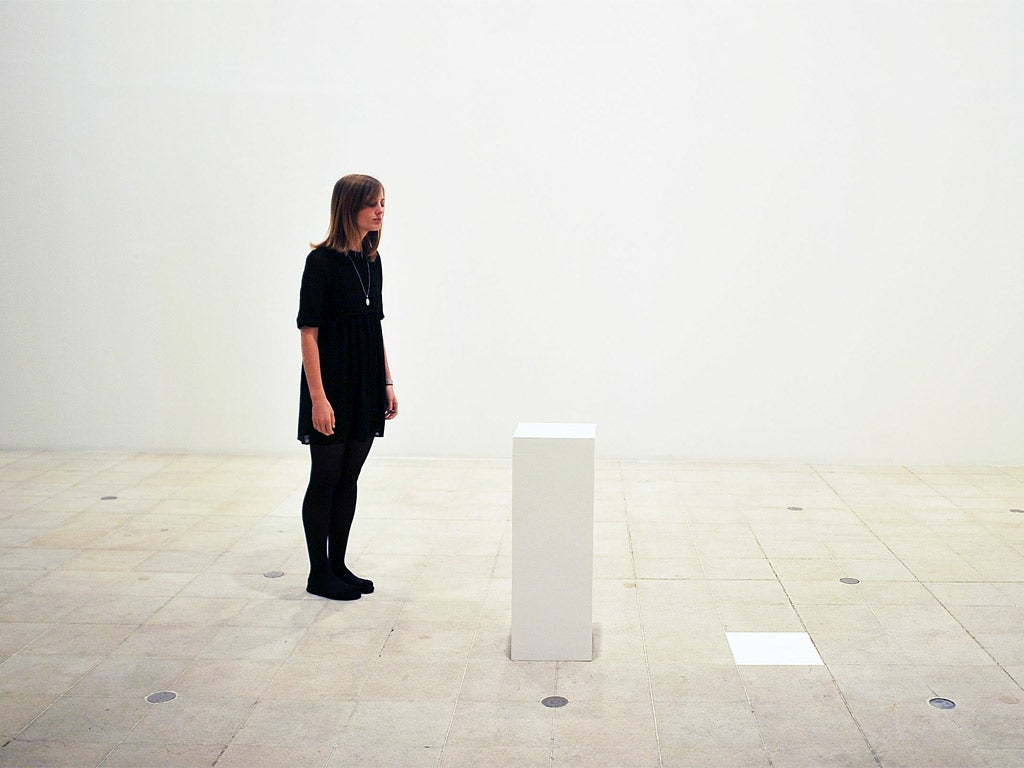Invisible, Hayward Gallery, London
Here's one empty space that Andy Warhol once stood in, and another empty space cursed by a witch ... if this a joke, then perhaps it's on us

Should the weather turn warm, I strongly recommend a visit to an installation by the Sixties group Art & Language, in a new exhibition at the Hayward Gallery. Called The Air-Conditioning Show, A&L's piece consists of a large, white room, empty but for two refrigeration units pumping out cool air. It wasn't at its best when I went – light rain, damp clothes – but The Air-Conditioning Show would be hard to beat on a hot summer's day.
Oh yes, the art. Pinned to the wall by the door to A&L's chiller are bits of paper typed with gnomic messages. The opening paragraph gives you a flavour. "It is obvious," says the paper, "that the elements of a given framework (and this includes the constitution of construct contexts) are not at all bound to an eliminative specifying system." To which you might reasonably say: "What?", or, alternatively: "What bollocks."
But then you are meant to. A&L's installation is in a show called Invisible. The work's date – 1966 – marks the moment when the visual arts in Britain were beginning to turn un-visual, when mere visuality was becoming suspect. Who can say why? The rise of critical theory, maybe, or the annexing of art schools by universities. Like many peculiar things, the tendency had come from France.
The earliest work in Invisible is the film of a 1957 show of non-existent paintings by that merry Parisian con-man, Yves Klein. In the film, Klein stares at a spot on a blank wall, strokes his chin thoughtfully, raises one eyebrow, stands back and stares at it some more. Clearly, the work is not invisible: I couldn't have just described it to you if it were. Rather, it is what we now call conceptual. The paintings are not so much not there as neither here nor there. What matters is the idea of them, the acting-out of looking at them, the very visible record of Klein's performance.
There is much more in the same vein in Invisible. In sequential Hayward rooms are empty plinths, one by Andy Warhol and the other by the American conceptual sculptor, Tom Friedman. Friedman claims to have hired a witch to curse the air above his plinth, which accounts for its title, Untitled (A Curse). Warhol once briefly stood on his, in 1985 in a New York nightclub. Invisible Sculpture depicts its maker's fabled interest in celebrity, Warhol believing (or at least affecting to believe) that the space above his plinth was eternally charged by the fact of his once having been there.
In much of this there is a suggestion of mockery, typified by Maurizio Cattelan's Untitled (Denunzio). Ten years after Warhol's performance, Cattelan reported the theft from his studio of an invisible sculpture to Italian police. His work is the framed copy of the ensuing police report. It seems a cheap shot. What Untitled (Denunzio) is in effect saying is: Look at me making fun of these stupid non-artists, and them falling for it.
At times, as in Art & Language's chilly room, it is we ourselves who are the butt of the joke. At others, as with Cattelan, we are invited to laugh with the artist, to join the charmed circle of the conceptually initiated. Neither option is particularly attractive. It is as though, faced with years of low-brow comparisons of conceptual art with the emperor's new clothes, artists have decided to pay their critics back in kind. Put nothing on a plinth, they say, and see how the idiots like it! Look, they're lapping it up! They're giving it a show at the Hayward!
The Air-Conditioning Show apart, can I recommend you see Invisible? Not entirely, and not just for the obvious reason. To get into the spirit, the exhibition's organisers have had its signage done in white on white, so that it is difficult to see (geddit?). But it is also hard to see the show's point.
For it to hang together, there would have to be a sense that the incorporeal, the non-existent, had come to have some more-or-less uniform meaning for the artists who use it – that it was now a material in the modern artistic armory as, say, oil paint was in the classical one, that it is part of the zeitgeist. Invisible doesn't make that case. Are the spaces above Warhol and Friedman's plinths one and the same? Are Yoko Ono's typewritten instructions for paintings and A&L's typewritten theory sheets other than coincidentally alike? Not really, or at least not in any way that I can see. But then maybe that is the point.
To 5 Aug (020-7960 4200).
Critic's choice
Anyone impressed by Grayson Perry's televisual musings on taste and class should seek out his Hogarth-inspired tapestries, The Vanity of Small Differences, at London's Victoria Miro Gallery (to 11 Aug). There's more than just tapestry as Tracey Emin takes to Margate – her new show at Turner Contemporary features drawings, painting and sculpture too (to 23 Sep).
Join our commenting forum
Join thought-provoking conversations, follow other Independent readers and see their replies
Comments
Bookmark popover
Removed from bookmarks